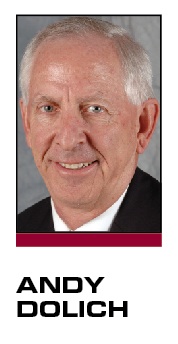The NBA is playing games in the desert. NHL hockey stars are skating around in baseball parks. College hoops heroes are slam-dunking on the deck of a nuclear-powered aircraft carrier. Football is being played in soccer stadiums, and futbol is kicking off in football stadiums. We have pro golf events under the lights and pro surfing on the beaches of New York. What exactly is going on here?
Is this shape-shifting of games and venues a fading fad or a future force? Are we going to see the Yankees and the Red Sox playing a game in Tiananmen Square in front of 450,000 Beijing baseball fans?
The NHL is talking about playing the Winter Classic in the Big House at Michigan in 2013. In 2010, 113,411 turned out for the Big Chill collegiate hockey matchup between Michigan and Michigan State. If this Big Chill Winter Classic is a success, might we soon see a game on a frozen Great Lake? This mega event could break all-time attendance records and be the first multiple sports triple-header. I can see it now: the NHL Winter Classic, with an NCAA Big Chill and the Bass Pro Shops Big Drill World Ice Fishing Championship as the nightcap. Just imagine the beer sales for this ice festival.
Sports is a follow-the-leader business, especially when it comes to testing new promotions and marketing platforms. As soon as one league, team or creative staffer comes up with a viable concept, everyone else falls in line. The variable-venue venture is the newest tool used to increase revenue in the world of sports.
We know that history is always our best teacher. So, where did this all start? In 1959, during the construction of Dodger Stadium, the Dodgers were playing baseball games at the football-configured Los Angeles Memorial Coliseum. Each of the three World Series games drew 92,000 fans. On April 6, 1965, the world’s first multipurpose domed sports stadium opened. The Houston Astros became the first Major League Baseball team to play indoors when the Astrodome hosted a preseason game with the Yankees. Nicknamed The Eighth Wonder of the World, the Astrodome was considered the ultimate stadium of the future. Today, only maintenance workers, security personnel and pigeons are allowed in.
The key factors working in favor of the continued expansion of traditional games in nontraditional settings are easy to understand:
■ Increased gross revenues.
■ Increased media exposure from outside the sports pages: “Look, grandma: There’s a hockey goalie at shortstop.”
■ It reconnects fans with a sport’s origins, like playing hockey on a frozen pond or hoops outdoors.
■ Watching players cope with unpredictable conditions.
■ The Woodstock factor: It’s cool to be at the game.
■ Breaking attendance records.
■ Giving fans a break from today’s hermetically sealed, overly programmed, stadiums and arenas.
But there are just as many reasons why the variable-venue venture may go the way of the XFL:
■ Unpredictable weather conditions. Shooting 3s in gale-force winds can be a bit difficult.
■ The live gate and TV revenue can be wiped out if games are postponed.
■ Fans want nanosecond newness. If the games become hackneyed, they will find alternatives for their disposable dollars.
■ A star player injury caused by the nontraditional venue.
■ Security concerns.
■ Fans are creatures of habits and don’t always accept change, especially if their season-tickets locations are compromised in an alternative venue.
■ Service issues.
Discussions are under way on the next big breakthrough venue. In order to capture hearts, minds, media and wallets, it will have to be out of this world. Some of us remember Commander Alan Shepard’s 6-iron on the moon on Feb. 6, 1971. I see a PGA “Sea of Tranquility Open” brought to you by Virgin Space Ventures in our future.
Andy Dolich (andy.dolich@gmail.com) has more than four decades of experience in professional sports, including executive positions in the NFL, MLB, NBA and NHL.




